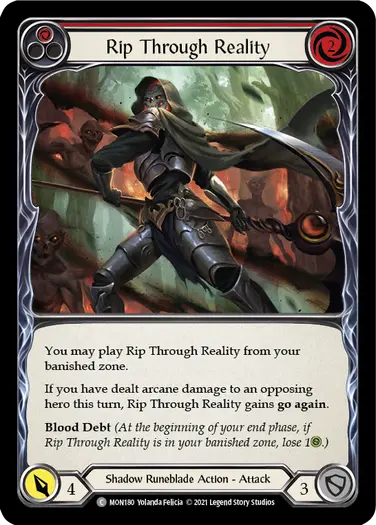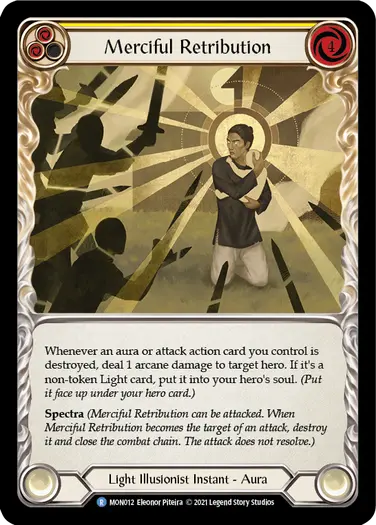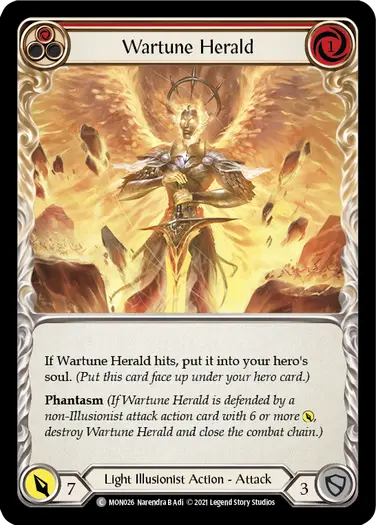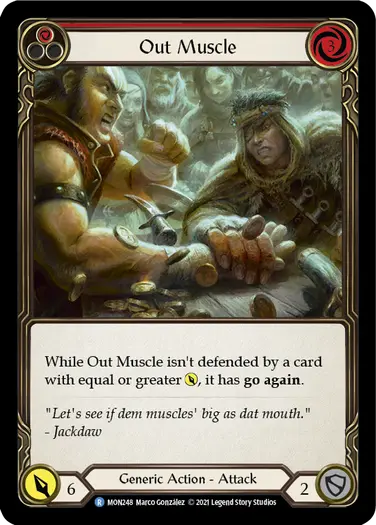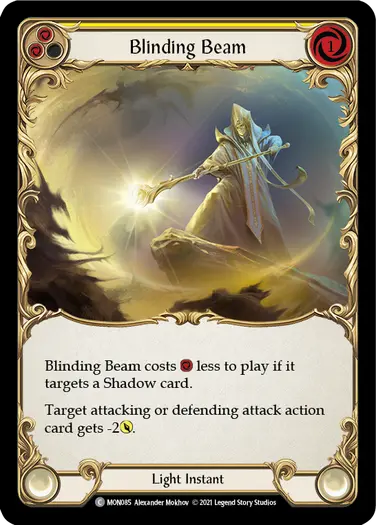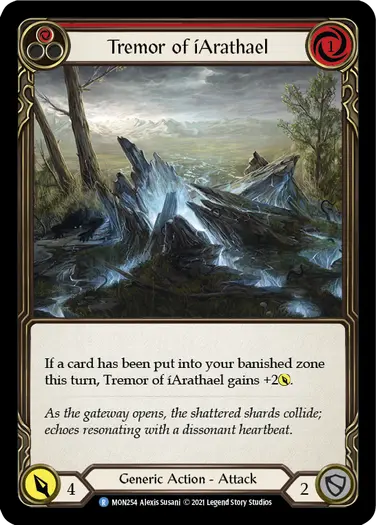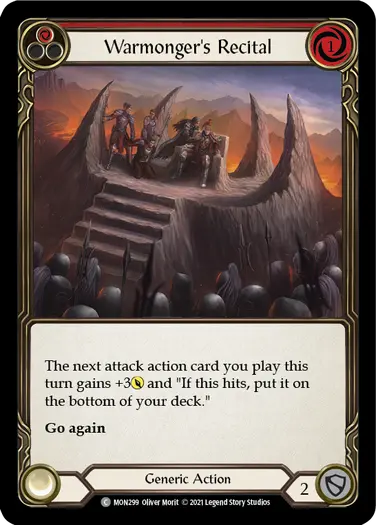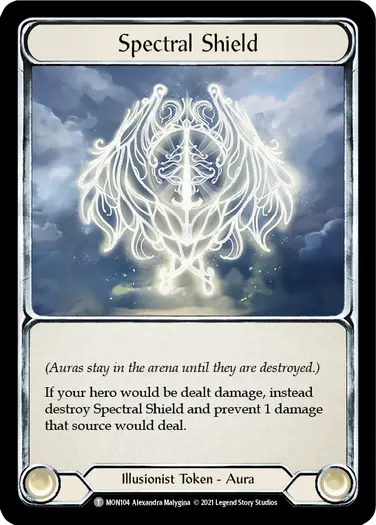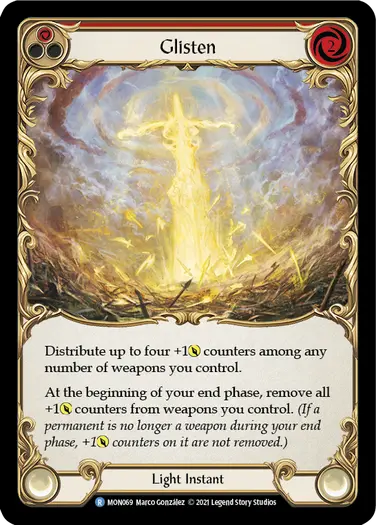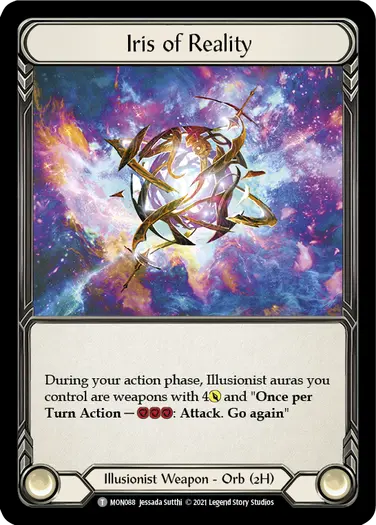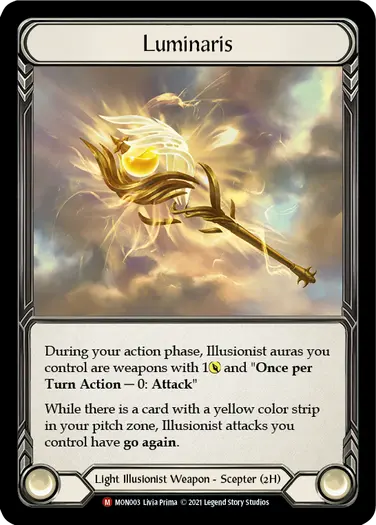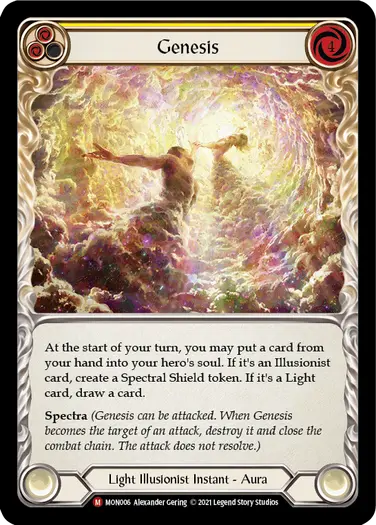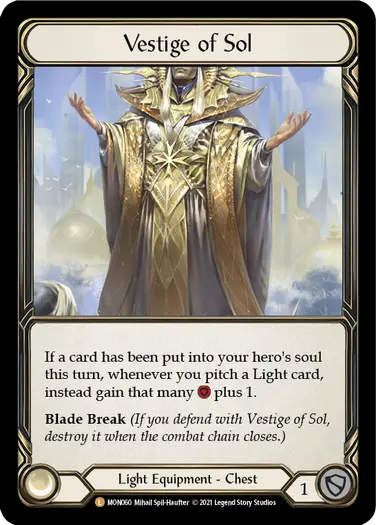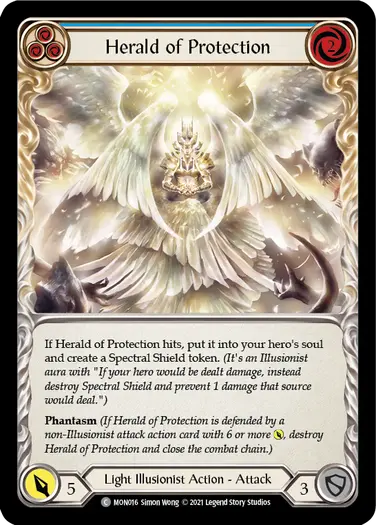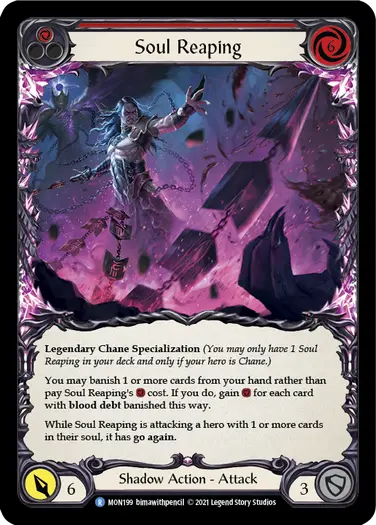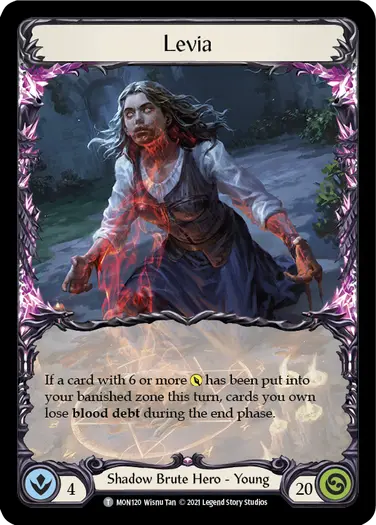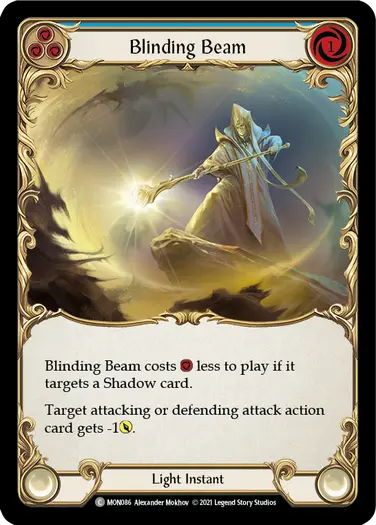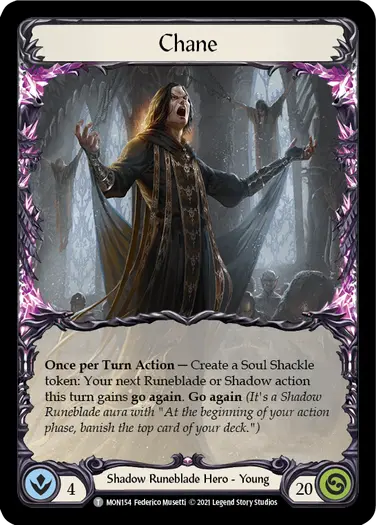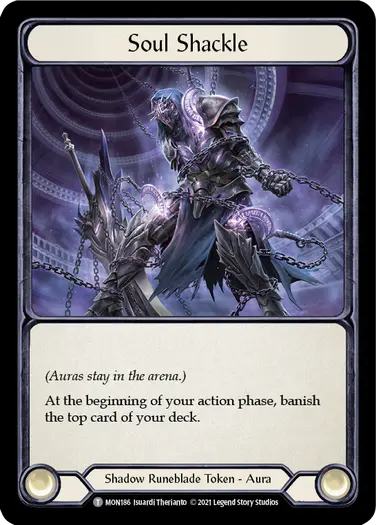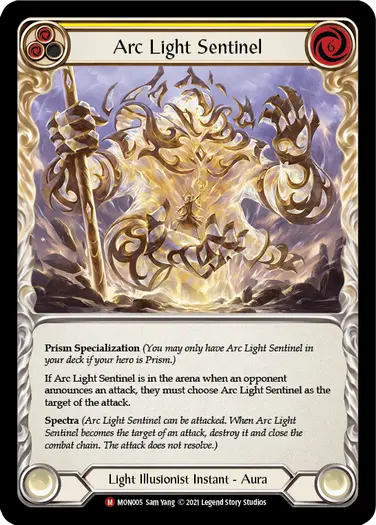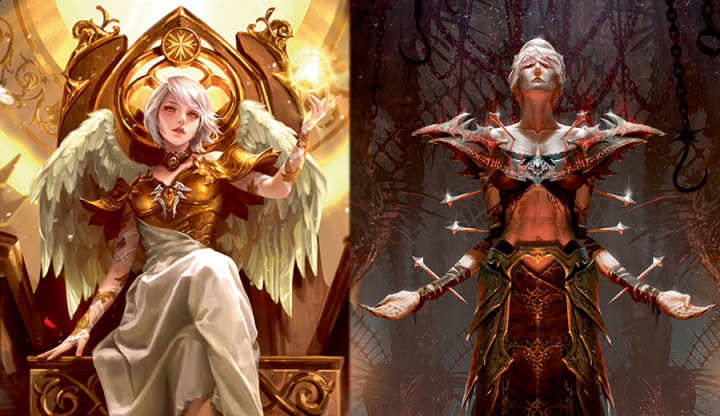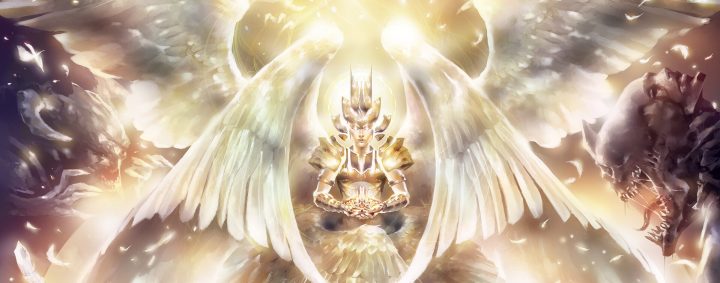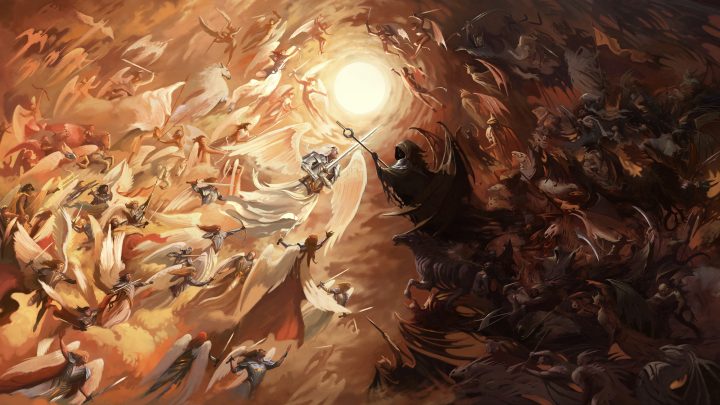Rules and Policy Manager Joshua Scott is back with a new installment of the rules reprise series. With Monarch Booster Draft at the forefront of the War of the Monarch Pre-Release weekend, National Championships, and Skirmish events worldwide, we are revisiting some of the format’s frequently asked questions and common interactions.
How does spectra work?
Spectra is a keyword found on many auras cards in Monarch. Players may choose to attack an object with spectra (instead of a hero or ally). Doing so will cause spectra to trigger its effect, closing the combat chain, and removing the attack from the stack. Here are the key aspects of targeting a permanent with spectra:
- Spectra cards can be targeted by attacks, but not by effects that deal damage (they don’t have a life total, so dealing damage does nothing anyway).
- When spectra triggers, the attack does not resolve. You aren’t considered to have attacked, and on-attack effects do not trigger.
- Runechants (and other on-play or on-activate effects) always trigger and resolve when targeting a spectra card, regardless of the combat chain closing.
- You can play and resolve instants before the combat chain closes, but can not stop the combat chain from closing.
One of the most important interactions to note is that, if you target a card with spectra with an attack, the combat chain closes and you do not gain an action point from go again. This means you must be careful about when and how you attack cards with spectra, otherwise your turn will come to a sudden halt without any action points to spend.
Tyler plays and resolves Seeds of Agony (red), then plays Rip Through Reality (red), with go again, targeting Nic’s Merciful Retribution. The spectra trigger resolves, the Merciful Retribution is destroyed, and the combat chain closes. As a result, Rip Through Reality is removed from the stack, and Merciful Retribution’s triggered effect is added to the stack. Because neither player has priority during the close step, Merciful Retribution’s triggered effect deals 1 arcane damage to Tyler and is placed in Nic’s soul. The triggered effect from Seeds of Agony never triggers because the Rip Through Reality never became attacking. Tyler does not gain an action point from Rip Through Reality (go again), because the attack is never resolved.
How does phantasm work?
Phantasm is a keyword found on Illusionist attack action cards in Monarch. This ability constantly looks at the power value of each defending card and triggers if any of them are non-Illusionist and have 6+ power. If the triggered effect resolves successfully, the card with phantasm is destroyed and the combat chain closes. Like spectra, if the card had go again, the controller does not gain an action point because the attack doesn’t fully resolve before the combat chain closes.
In order for phantasm’s triggered effect to resolve, it must still be defended by a non-Illusionist attack with 6+ power at the time of resolution. Phantasm on an attack can trigger with a defending non-Illusionist card that has 6+ power; however, if that defending card were 5 power or lower, the phantasm trigger would not resolve. This means there’s a window where phantasm may trigger, and players can respond before it would be resolved.
Tyler attacks with Wartune Herald (red), and Nic defends with an Out Muscle (red), triggering the phantasm ability on the Wartune Herald. Before the phantasm triggered effect resolves, Tyler resolves Blinding Beam (yellow), giving the defending Out Muscle −2 power. When phantasm begins to resolve, the game state that caused phantasm to trigger is no longer true. The trigger fails to resolve, the combat chain does not close, and combat continues as normal.
As a final note, the text on the majority of cards is not functional when it is defending on the combat chain. The exceptions to this are permanents (e.g. equipment) and abilities that explicitly state that they work while defending (e.g. Yinti Yanti). This means cards like Tremor of iArathael (red) don’t cause phantasm to trigger, even if you’ve banished a card this turn.
What happens if I play Warmonger’s Recital then hit with a Herald?
You choose where the Herald ends up.
The location of where the Herald ends up is dependent on which triggered effect resolves first in the resolution step. When there are multiple triggered effects that trigger from an event (e.g. the hit event), the turn player will decide the order of how those triggered effects enter the stack before they receive priority. If the order of the stack results in the Warmonger's Recital's triggered effect resolving first, then the Wartune Herald will end up on the bottom of the deck; similarly if Wartune Herald’s triggered effect resolves first, then it is put into the hero’s soul. Once it ends up in a location its position will not change when the remaining triggered effect resolves (because the card isn’t on the combat chain anymore).
Tyler plays and resolves Warmonger’s Recital (red) then hits Nic with a Wartune Herald (red). In the resolution step, Tyler decides to have the Warmonger’s Recital triggered effect as Layer 1 and Wartune Herald’s triggered effect as Layer 2. Wartune Herald’s triggered effect (Layer 2) resolves first and puts the Wartune Herald into Tyler’s soul. Then, Warmonger’s Recital’s triggered effect (Layer 1) resolves; however, it does not move the Wartune Herald from the soul to the bottom of the deck because the Wartune Herald is no longer on the combat chain to be moved.
What happens if I attack someone who has a Spectral Shield and Merciful Retribution?
You deal the damage first (if any), and then if you haven’t won the game, Merciful Retribution’s trigger will then deal damage to you.
First the damage is dealt in the damage step of combat. This is partially prevented by any Spectral Shields the opponent has, destroying the Spectral Shields in the process. The damage must be completed before moving onto the next step of combat. Second, if the opponent is now at 0 life, you simply win the game, if not, combat continues. Third, Merciful Retribution’s triggered effects are put onto the stack to resolve – one for each Spectral Shield that was destroyed.
Tyler and Nic are on 1 life total each. Nic controls a Merciful Retribution and a single Spectral Shield. Tyler attacks Nic with a 2 power attack and Nic does not defend the attack. During the damage step of combat, the damage is reduced from 2 to 1, destroying the Spectral Shield and reducing Nic’s life total to 0. Tyler wins the game before the trigger of Merciful Retribution has resolved.
Are +1 power counters from Glisten removed at the end of turn from Illusionist auras?
No, they are not removed (but only if you control Iris of Reality or Luminaris)
The abilities on Iris of Reality and Luminaris make Illusionist auras you control into weapons ONLY during your action phase. The delayed-triggered effect from Glisten that removes +1 power counters from weapons you control would resolve in the player’s end phase. As the Spectral Shields are no longer weapons in this phase, they would simply just keep the counters on them.
Tyler controls an Iris of Reality and attacks Nic with a Spectral Shield. During the reaction step, Tyler plays and resolves Glisten (red), putting all four +1 power counters onto the Spectral Shield. Tyler moves to the end phase of the turn; the Spectral Shield is no longer considered a weapon. Glisten’s delayed-triggered effect resolves and does not remove the +1 power counters from the Spectral Shield because it is not a weapon at this point in time.
It is worth noting that this does not apply to Reality Refractor (coming in Dusk till Dawn), as this new card has an effect that causes your Illusionist auras to ALWAYS be considered weapons, and thus all +1 power counters would be removed from these auras during your next end phase.
If I attack with a Spectral Shield that has go again and it is destroyed, do I still get an action point?
If it’s destroyed before dealing damage (if any), no. The attack no longer exists and hasn’t resolved, so the combat chain closes before you reach the link step of combat (where you would have gained the action point).
If it’s destroyed after dealing damage (if any), yes. After dealing damage and moving into the resolution step of combat, the attack is considered resolved. It essentially doesn’t matter what happens to it at this point, if it gets destroyed the combat chain will not close. If the Spectral Shield had go again before it was destroyed in the resolution step, Last Known Information (LKI) is used to determine if it had go again, so you still gain the action point in the link step of combat.
Tyler controls an Iris of Reality and a Spectral Shield. Nic controls Merciful Retribution and a Spectral Shield. Tyler attacks Nic with their Spectral Shield and Nic does not defend. The damage is partially prevented by Nic’s Spectral Shield (which is destroyed), During the resolution step, the Merciful Retribution trigger resolves and attempts to deal 1 arcane damage to Tyler. Tyler’s Spectral Shield prevents this 1 damage and destroys itself. Because the attack has already resolved (resolution step), the combat chain does not close. Because it had go again before it was destroyed, LKI is used to determine that it had go again, so Tyler gains an action point in the link step of combat.
I want to end my action phase with an action point, can the opponent respond? Can I still attack them after?
Yes and yes.
In short, ending your action phase requires both you and your opponent to pass priority when there’s nothing on the stack (i.e. nothing left to resolve before the end of the turn). Once you pass priority, your opponent has the chance to play instant cards (e.g. Genesis) or activate instant abilities (e.g. Prism). After the layer resolves, you’re still considered to be in the action phase as you have not passed in succession on an empty stack. This of course means that if you have an action point, you may still play an action during your action phase and before you end the turn.
Tyler has the first turn of the game, decides not to play any cards, and wants to end their turn (passing priority). Before moving to the end phase, Nic plays and resolves Genesis, hoping to use its ability on the start of their turn. Tyler now has priority, an action point, and it is still their turn. Tyler plays an attack, targeting Nic’s Genesis, destroying it and closing the combat chain. Both players pass priority on the empty stack, moving from the action phase to the end phase of Tyler’s turn, then ending Tyler’s turn.
When do I gain the resource from Vestige of Sol?
Exactly at the time that you pitch, if you meet Vestige of Sol’s condition.
Vestige of Sol has a replacement effect that modifies the resources you gain when you pitch a light card, gaining you an additional resource point. It is important to note that Vestige of Sol got an errata that updated its effect to be a replacement effect rather than a trigger effect that was otherwise printed on the first and unlimited editions of the card. With the most recent syntax it currently reads:
“If a card has been put into your hero's soul this turn, whenever you pitch a Light card, instead gain that many {r} plus 1.”
Note that you pitch to pay the resource cost of a card before paying any additional costs (such as charging your hero’s soul). So, in cases where you’ve put a card into your hero’s soul before paying the cost of playing the card or activating an ability, your light cards essentially pitch for 1 more.
Tyler controls a Vestige of Sol and has put a card into their soul this turn. Tyler plays Merciful Retribution, pitching a Herald of Protection (blue). This fully pays for Merciful Retribution’s resource cost as 4 resource points were generated from pitching the blue herald instead of 3 resource points, due to Vestige of Sol’s replacement effect.
Does Soul Reaping still have go again after my opponent banishes the last card from their soul?
No.
Soul Reaping has a static ability that is constantly checking the opponent’s soul for cards. If there is one or more cards in their soul, Soul Reaping has go again. If there are no cards in their Soul Reaping does not have go again. Go again is checked in the link step (after damage has been dealt and the resolution step is finished), which means that a player could remove the last card from their soul between Soul Reaping dealing damage, and the attacker gaining an action point from go again.
Nic is playing as Prism and has one card in their soul. Tyler attacks Nic with Soul Reaping, which currently has go again, and Tyler does not defend or prevent any damage. Tyler takes 6 damage, then activates and resolves Prism’s ability, banishing a card from their soul, and creating a Spectral Shield. Because there are not cards in Nic’s soul anymore, the Soul Reaping doesn’t have go again anymore, so Tyler does not gain an action point during the link step.
How does Levia’s ability work with attack action cards that had their power modified and then banished?
Levia’s ability cares about the power of the card at the time it is banished, not just the base power printed on the card. If a card had its power reduced below 6 and it gets banished, it would not meet the requirement for Levia’s ability. However, if a card has its power increased to 6 or above and it gets banished, it would meet the requirement. Whatever happens to the power of the card after it is banished is irrelevant
Tyler attacks Nic with Mark of the Beast. Nic plays and resolves Blinding Beam (blue) lowering Mark of the Beast’s power from 6 to 5. Tyler closes the combat chain, and Mark of the Beast is banished (due to its replacement effect). Because it had 5 power at the time when it was banished (from the combat chain), Levia’s ability’s condition is not met and cards in Tyler’s banished zone do not lose blood debt during Tyler’s end phase.
Can I respond to Soul Shackle triggers?
Yes.
Soul Shackle triggers during the beginning of the player’s action phase, which means that players have priority to play cards. Each Soul Shackle produces a separate triggered layer, which means that either player has the opportunity to play instant cards or activate instant abilities before any one of the Soul Shackle triggers resolve. When each trigger resolves, a card is banished from the top of the player’s deck.
Tyler has 3 Soul Shackles in their arena. At the beginning of their action phase, all 3 Soul Shackles trigger. Both players pass priority and resolve the first 2 Soul Shackle triggered effects, resulting in Tyler banishing a total of 2 cards from the top of their deck at this point. Before the last Soul Shackle triggered effect resolves, Nic plays and resolves Arc Light Sentinel, putting it into the arena. Both players then resolve the last Soul Shackle triggered effect.

